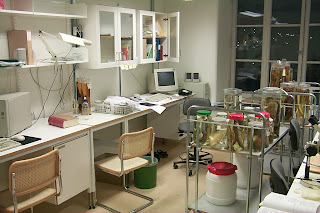Some of you may have observed the excellent movie by Elizabeth Watson for the Artedi Symposium in 2005. It misses the Artedi part, however. Now, Elizabeth kindly made available also this critical drama. Petrus Artedi working at the waterfront, barefoot, quill pen in hand and on the whole rather charming and primitive. Starring Jonathan Ready in 18th century outfit worthy of any ichthyological master.
Swedish as we are, and I grew up fishing in Örnsköldsvik not many kilometers from Artedi’s birthplace in Anundsjö (many years later, though, he moved to Nordmaling before I arrived), we cannot simply forget the man who discovered systematics, the genus concept, and the descriptive method of Ichthyology, although everyone else seems willing to do so. The discussion goes on and on, did Linnaeus simply plagiarize Artedi? Ted Pietsch, American but from Washington state which is almost as cold as Sweden, has a new book out on the interaction between Linnaeus and Artedi, which will be given some lines here eventually. The Royal Skyttean Society, one of Sweden’s 18 noble academies, just published the proceedings of their Artedi Symposium in 2005, and in 2011 it is again time for the third Artedi lectures event.
To those who haven’t heard of Artedi, but are going to watch Elizabeth’s film: Petrus Artedi, born 1705, in Anundsjö, north Sweden, studied with Linnaeus in Uppsala, sharing interest in natural history and classifications. Both then travelled to the Netherlands to study and graduate. In 1735, Artedi drowned in a canal in Amsterdam. Linnaeus took care of his manuscripts and published them in 1738 as Ichthyologia, sive Opera omnia de Piscibus, which was a highly innovative and complete treatise of ichthyology. The fish taxonomy in it found its way into Systema Naturae. The film was shot in September 2005 on the bank of Edsviken Bay, on the premises of the Ulriksdal Palace, the first building dating to 1643, home to queens and kings, among them Adolf Fredrik and Lovisa Ulrika (1720-1782), whose natural history collections were studied by Linnaeus. It is now the seat of Swedish WWF. For what we know, Artedi was never there, but Linnaeus was (me too), and you can feel the 1700s in the bare branches of the trees, the water’s reflections, and Artedi’s frozen feet.
